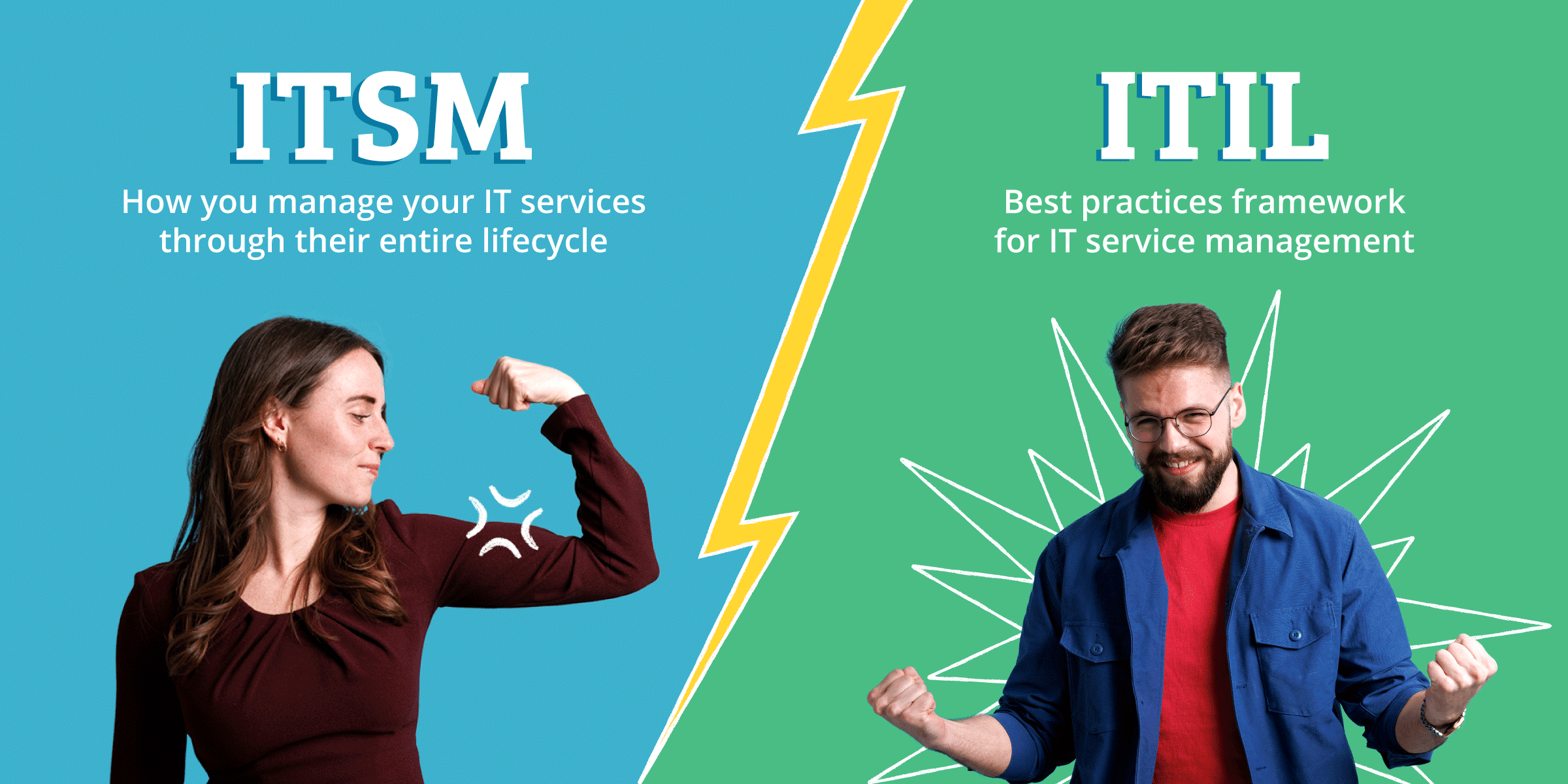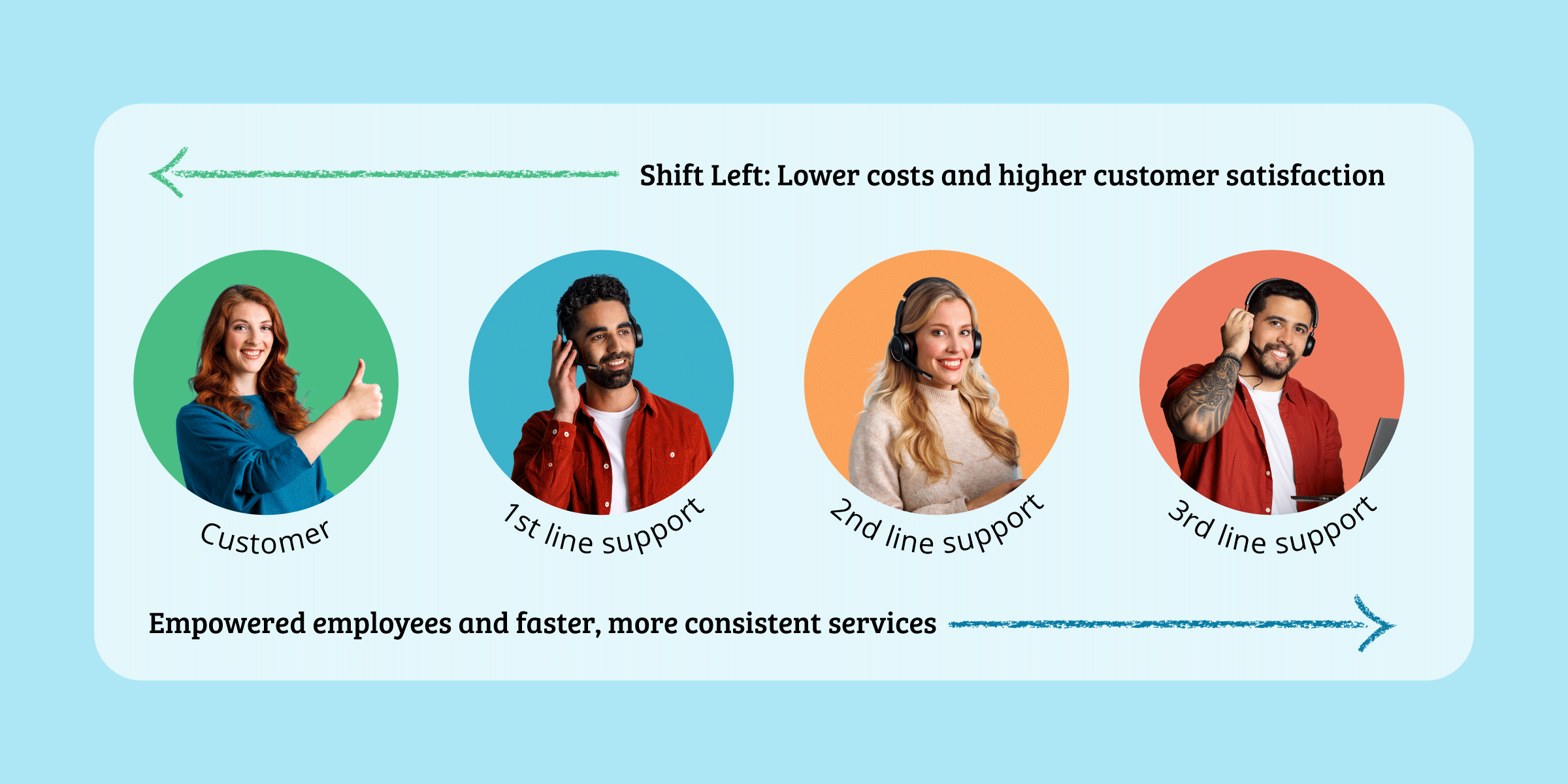What is IT Service Management (ITSM)?
IT service management (ITSM) is the practice of designing, delivering, managing, and improving IT services to meet business goals and enhance customer satisfaction.
Download the e-bookWhat is ITSM?
We touched on it in the intro above, but ITSM refers to the activities, processes and guidelines needed to set up IT service management within your organization. The goal of ITSM is to make your IT services more efficient and effective to meet the needs of internal and external customers.
Implementing ITSM software can greatly facilitate these processes by automating routine tasks, improving workflow, and providing valuable insights through advanced reporting features. This not only enhances service delivery but also boosts overall customer satisfaction. Implementing an effective ITSM tool is crucial for streamlining your IT services.
How long has ITSM been around?
ITSM emerged in response to the increasing complexity of IT environments and the need to manage IT services more effectively. It was formed from several disciplines and best practices, including ITIL (Information Technology Infrastructure Library), COBIT (Control Objectives for Information and Related Technologies) and ISO/IEC 20000 (International Standard for IT Service Management).
The concept of ITSM started in the 1980s and 1990s, when organizations realized that IT services were essential to their operations. With the growing reliance on technology, the need for standardized processes and best practices to better manage and support IT services also increased.
Meanwhile, ITSM has evolved into a broad field in which various aspects of IT service management have their place. Examples include incident management, problem management, change management and configuration management. ITSM is considered an essential part of IT governance and operations for organizations around the world.
What to learn more about the world of ITSM? Here are 26 ITSM terms you need to know.

Learn more about what ITSM is in this video
Is ITSM still relevant today?
In a world that revolves around digital innovation and technological advances, ITSM is more relevant today than ever. With the sharp increase in complexity of the IT landscape and an increasing reliance on digital services, ITSM is part of the backbone of any modern business.
ITSM also arms your organization against increasing cyber threats and strengthens your cybersecurity. Cybercrime is becoming more sophisticated and laws and regulations surrounding data privacy and security continue to increase. ITSM offers a standard approach to guaranteeing the security of your organization’s sensitive information and, therefore, business continuity.
With ITSM, you make your organization more flexible so you can respond quickly and appropriately to changes in customer preferences and opportunities that arise in the marketplace.
In short, ITSM is no longer just a part of your IT strategy, but an essential pillar for the success of your organization in this modern digital economy.
Digitize your service delivery with ITSM software
Looking for the right ITSM solution? TOPdesk’s ITSM software brings your IT services together in one place, so it’s easy to share knowledge, answer questions and solve problems. You’ll give agents time to spare, and customers a reason to be happy.
Read more about our ITSM softwareWhat are the ITSM processes?
How does ITSM work? Here are five examples of ITSM processes:
- Change and Release Management. This includes changes as simple as replacing a PC. Or as complex as introducing a new software package.
- Asset Management. Here you register and keep track of everything your customers need. From object types to licences.
- Problem Management. With problem management, you pinpoint and fix major structural problems within your organization.
- Incident Management. Incident management helps you register and process all complaints, wishes and requests from (internal) customers.
- Resource Management. Stay on top of employees’ availability and workload.
How does IT Service Management relate to ITIL?
How do we see ITSM vs ITIL? IT service management is often mentioned in the same breath as ITIL. What is ITIL? ITIL is short for Information Technology Infrastructure Library. Do you want to improve your services? Then it’s important to realize that you don’t have to choose between ITSM and ITIL.
ITSM is all about how you manage the services you offer customers. This includes how you plan, design, deliver, operate and control your services. ITIL is one of the frameworks that offer best practices for implementing IT Service Management.
In other words: ITIL is a collection of processes, lists, strategies and values for ITSM.

Is Service Management just for IT? Say hello to Enterprise Service Management (ESM)
No, it’s not.
Departments like Facilities and HR also offer internal services. Just like the services at the IT department, this boils down to the same thing: supporting colleagues in their daily tasks. HR also handles incidents. And looks for ways to manage problems and changes. The same applies to FM, where the infrastructure isn’t an IT organization, but a building.
All supporting departments can benefit from service management. Matter of fact: it’s far more efficient and customer-centric if all supporting departments work together. And if they offer services in the same way. We call this Enterprise Service Management. And it’s catching on fast.

Key ITSM trends in 2024 and beyond

Staying on top of the latest developments and trends will help you know which developments and challenges may impact ITSM in your organization.
Every year we see new developments in the field of ITSM. Sometimes they are novelties, but it may also be that the importance of a particular trend suddenly increases. ITSM trends arise because of technological innovations, changes in laws and regulations, new best practices or changing customer demand.
When evaluating trends, it’s obviously important to understand what they mean. But just as essential is to consider what effect they will have on the way you work.
Do ITSM trends make the work of the IT service team easier and more engaging, do they allow you to save costs or do they give you more control over daily processes? You may also be forced to jump on board – simply because everyone else is doing it.
Want to learn more about ITSM trends? Check out the following blogs:
Blog: The top 4 ITSM trends in 2024
Blog: The inevitable integration of AI into IT service management: curse or blessing?
Blog: Why customers are increasingly demanding and what this means for your IT
Digitize your service delivery with ITSM software
Looking for the right ITSM solution? TOPdesk’s ITSM software brings your IT services together in one place, so it’s easy to share knowledge, answer questions and solve problems. You’ll give agents time to spare, and customers a reason to be happy.
Read more about our ITSM softwareWhat is Workforce enablement?
Workforce enablement is all about improving customer satisfaction with innovative technology. It’s based on the idea that your customers’ needs are changing. They work on the go, use their own apps and devices, and want to solve their own problems. This requires a new approach to ITSM. You no longer focus on SLAs and resolution times, but make sure customers are happy and have everything they need to do their jobs. Read more about the ins and outs of workforce enablement.
What is DevOps?

DevOps is becoming one of the main movements in ITSM. Basically, DevOps uses software development and IT operations in one department or team. DevOps breaks down the traditional barriers between development and IT operation. For instance: budget, functional requirements and performance. By working together, DevOps helps an organization evolve and improve products faster. In turn, organizations can help their customers better and compete more effectively in the market.
What is Shift Left?

Shift Left as a trend continues to grow in the industry. The idea behind shift left? IT brings their solutions, such as answers to frequently asked questions, closer to the customer.
With Shift left, you reduce the pressure on your IT department. It gives service desks more time to solve problems instead of spending hours on working through password resets and software requests. But it also adds value to the customer another way. Want to learn more? Read about what shift left means for IT service desks.
How to select the right ITSM tool

Choosing the right ITSM tool is crucial for making sure your IT services run smoothly and efficiently – and that you’re set up for the years to come. With so many options out there, it’s important to look at things like how well the tool can grow with your business, how easily it connects with other systems, how simple it is to use, and the kind of support you get from the provider.
A good ITSM tool should not only make your IT team’s job easier but also keep your customers happy by making their experience as smooth as possible. If you need help figuring out which tool is best for your organization, take a look at this comprehensive ITSM tool selection guide.
How to build an ITSM business case
Building a business case for ITSM is crucial for justifying the investment, gaining stakeholder buy-in, and clearly articulating the value and benefits to the organization.
Creating a business case for ITSM involves clearly outlining the benefits and value it will bring to your organization. Start by identifying the current challenges and inefficiencies in your IT processes and how an ITSM solution can address them. Include potential cost savings, improvements in service quality, and enhanced customer satisfaction. Make sure to provide concrete examples and data to support your claims. For a detailed guide on how to effectively write a business case for ITSM, check out this blog on how to build an ITSM business case.
How can I start with ITSM?
Simply put, ITSM is about how you manage the information systems that deliver value to your customer. This is not limited to the standard servers, laptops and software packages.
IT service management also helps you to schedule and manage changes. This helps you prevent disruptions to the business and fix impediments. You can also manage contracts with suppliers, so you aren’t surprised by a sudden contract renewal or termination.
Luckily, you’re not alone in managing all these information technology aspects. A professional ITSM tool, like TOPdesk IT Service Management helps you automate your ITSM processes, increase efficiency and reduce costs. Most importantly, it helps you reach your goal: happy customers.
Want to get some insights into what an ITSM implementation should look like? Check out our blog on the steps for a successful ITSM implementation or read about the five most common ITSM implementation pitfalls so you can avoid them during your own implementation.
Best practices for your IT department
In today’s service landscape, the success of your service delivery relies heavily on your customers’ happiness. But how do you get satisfied customers, when most IT frameworks still focus on tools and processes? These best practices offer an answer.
Download the e-book